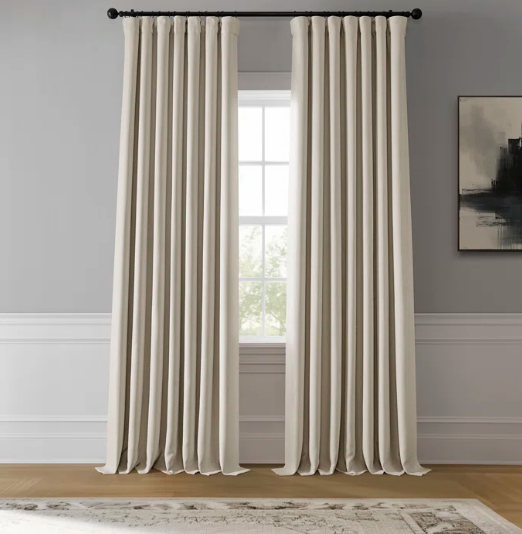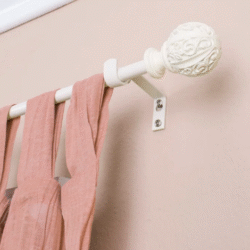Vintage lace curtains bring a timeless elegance to any home, blending intricate craftsmanship with nostalgic charm. These delicate, handwoven fabrics have stood the test of time, often evoking a sense of romanticism and vintage allure. Whether draping over windows in a cozy cottage or enhancing the décor of a more modern space, vintage lace curtains offer a unique blend of beauty and history. Their delicate patterns and soft textures not only allow natural light to filter through but also add a touch of grace to any room. In this article, we will explore the history, charm, and modern-day appeal of vintage lace curtains, highlighting why they continue to be a beloved choice for interior design enthusiasts.
The History of Vintage Lace Curtains: A Glimpse into the Past
- Origins of Lace: Lace dates back to the 16th century in Europe, primarily in Italy and Belgium, where it was initially crafted by hand using fine threads of silk, linen, and cotton.
- Rise in Popularity: Lace became highly fashionable in the 17th and 18th centuries, with aristocrats and royalty using it to adorn clothing and household items, including curtains.
- Industrial Revolution Impact: The invention of lace-making machines in the 19th century made lace more affordable and accessible to the middle class, leading to the widespread use of lace curtains in homes.
- Victorian Era Influence: During the Victorian era, lace curtains became a hallmark of domestic elegance, symbolizing both wealth and refined taste. They were often used in parlors and drawing rooms.
- Craftsmanship and Artistry: Vintage lace curtains were often handmade by skilled artisans, with intricate designs passed down through generations, showcasing the exceptional craftsmanship of the time.
- Cultural Significance: Lace curtains also carried cultural symbolism, representing modesty and privacy, as they were commonly used in windows to provide a sense of seclusion while allowing light to enter.
- Decline and Revival: While their popularity declined in the 20th century with the advent of synthetic fabrics, vintage lace curtains have experienced a resurgence in recent years due to their nostalgic charm and timeless beauty.
Why Vintage Lace Curtains Are Timelessly Elegant
Vintage lace curtains are timelessly elegant because they embody a unique blend of craftsmanship, history, and delicate beauty that transcends trends. Their intricate patterns, often created by hand, offer a level of artistry that is rarely seen in modern textiles. The fine details of vintage lace curtains, whether floral motifs or geometric designs, evoke a sense of nostalgia and refinement that connects us to past eras, such as the Victorian and Edwardian periods, when lace was a symbol of luxury and sophistication.
One of the key reasons vintage lace curtains remain so timeless is their versatility. They can easily complement both traditional and modern interiors, providing a soft contrast to contemporary furnishings or enhancing the charm of classic home décor. The lightness and airiness of lace allow natural light to filter through, creating a warm, inviting atmosphere in any room. The delicate texture also adds a subtle layer of elegance that’s both understated and luxurious.
Moreover, vintage lace curtains have a sense of history that mass-produced curtains lack. Each piece often carries a story, whether it’s the handcrafted techniques passed down through generations or the unique patina that age brings to the fabric. This sense of individuality and craftsmanship gives them a special place in interior design, where their beauty and elegance remain relevant, no matter the passing of time or changing trends.
The Craftsmanship Behind Vintage Lace Curtains
The craftsmanship behind vintage lace curtains is a testament to the skill, patience, and artistry of the makers who dedicated countless hours to create these delicate and intricate pieces. Lace-making, a centuries-old art, requires a deep understanding of techniques and a keen eye for detail. The process typically begins with selecting high-quality threads, often made from cotton, linen, or silk, which are then carefully woven or knotted to form the lace’s delicate patterns.
Historically, lace was made by hand using various methods, such as bobbin lace or needle lace. Bobbin lace, one of the most traditional forms, involves winding thread around small wooden spools (bobbins) and intertwining them on a pillow to create intricate designs. Needle lace, on the other hand, uses a needle to stitch threads together into elaborate patterns. Both methods require exceptional dexterity and precision, with each stitch contributing to the overall beauty and complexity of the curtain.
The designs of vintage lace curtains often reflect the era in which they were made. Victorian-era lace curtains, for instance, frequently featured floral motifs, while Art Nouveau lace might include flowing, organic patterns. These hand-crafted designs not only showcase the technical expertise of the artisan but also reflect cultural influences and personal creativity.
Vintage lace curtains represent more than just decorative elements; they embody the artistry and dedication of the craftsperson. Their beauty lies not only in their delicate appearance but in the time and skill that went into their creation, making them treasured pieces of heritage.
Caring for and Maintaining Vintage Lace Curtains
- Gentle Washing: Hand wash vintage lace curtains in cold water using a mild detergent to preserve the delicate fibers. Avoid using harsh chemicals or bleach.
- Avoid Wringing: Never wring or twist lace curtains to remove excess water, as this can damage the intricate threads. Instead, gently press out the water between towels.
- Drying: Air dry lace curtains by laying them flat on a clean, dry surface, or hang them in a shaded area to prevent sun damage. Avoid direct sunlight, which can cause the fabric to fade and weaken.
- Ironing with Care: If necessary, iron lace curtains on a low heat setting, placing a cloth between the lace and the iron to protect the fabric from direct heat.
- Storage: Store vintage lace curtains in a cool, dry place, away from direct sunlight, to prevent discoloration. Use acid-free tissue paper or garment bags for added protection.
- Avoid Heavy Handling: Handle lace curtains gently to avoid stretching or tearing. When hanging, use lightweight curtain rods to prevent putting unnecessary strain on the fabric.
- Regular Dusting: Lightly dust lace curtains with a soft brush or vacuum with a low suction setting to keep them clean without damaging the delicate threads.
- Professional Cleaning: For deep cleaning, consider taking vintage lace curtains to a professional cleaner who specializes in delicate fabrics to ensure their longevity.
How Vintage Lace Curtains Enhance Home Décor
Vintage lace curtains can significantly enhance home décor by adding a touch of elegance, warmth, and timeless charm to any space. Their delicate, intricate patterns and textures create a soft, inviting atmosphere that instantly elevates the aesthetic of a room. The fine lace allows natural light to filter through while providing a sense of privacy, striking the perfect balance between function and beauty.
In traditional or vintage-inspired interiors, lace curtains are a natural fit, complementing antique furniture and decorative elements. They evoke a sense of nostalgia, making them ideal for creating a cozy, romantic atmosphere. The subtle yet sophisticated designs of vintage lace add visual interest and a sense of refinement without overwhelming the space.
In modern homes, vintage lace curtains can serve as a unique contrast to more minimalist or contemporary furnishings. They soften sharp lines and industrial materials, providing a delicate, feminine touch. Whether used in the living room, bedroom, or even kitchens, lace curtains add a layer of texture and warmth, transforming the ambiance of the room.
Additionally, vintage lace curtains are incredibly versatile, working well with various color schemes and design styles. From soft neutrals to bold, contrasting tones, their timeless elegance complements any décor, making them a cherished addition to any home.
conclusion
In conclusion, vintage lace curtains are more than just a functional element in home décor; they are a beautiful blend of craftsmanship, history, and elegance that continues to captivate interior design enthusiasts. Their delicate patterns, rich heritage, and timeless charm make them a versatile addition to any space, whether enhancing a traditional setting or providing a striking contrast in modern interiors. By caring for and maintaining these exquisite pieces, we can preserve their beauty for generations to come, allowing future homeowners to experience the same elegance and warmth that vintage lace curtains have brought to countless homes throughout history. Ultimately, these curtains are not only a nod to the past but a timeless treasure that continues to bring grace and character to our living spaces.



